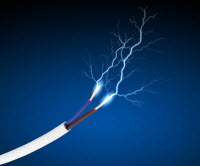Arc flash explosions are a daily occurrence in U.S. workplaces. Here are some tips for safeguarding your employees from these potentially fatal incidents.
What is arc flash and why is it hazardous? An arc flash is a short circuit through the air. In an arc flash incident, an enormous amount of concentrated radiant energy explodes outward from electrical equipment, creating:
 |
- Pressure waves that can damage your hearing, fracture ribs, collapse lungs, and knock you off a ladder or blow you across a room
- Pressure waves that can send loose material like pieces of damaged equipment, tools, and other objects flying through the air at speeds in excess of 700 miles per hour
- A high-intensity flash that can damage your eyesight and leave you blind
- A superheated ball of gas with temperatures in excess of 5,000 degrees that can ignite your clothing and cause serious burns over much of your body
What causes arc flash? Arc flash occurs when electrical current flows between two or more separated energized conducting surfaces. Common causes of arc flash include:
- Insulation failure
- Buildup of dust, impurities, and corrosion on insulating surfaces, which can provide a path for current
- Equipment failure due to use of substandard parts, improper installation, or even normal wear and tear
- Birds, bees, and rodents snapping leads at connections
- Human error, including dropped tools, accidental contact with electrical systems, and improper work procedures
How can you prevent arc flash injuries? The best way to prevent arc flash injuries is to make sure employees de-energize equipment before beginning work.
- Employees should not work on live equipment greater than 50 volts unless (1) de-energizing introduces additional or increased hazards such as cutting ventilation to a hazardous location; or (2) it’s impractical because of equipment design or operation limitations, such as when voltage testing is required for diagnostic purposes.
- When it is necessary to work on energized equipment, employees should always follow safe work practices, including assessing risks, wearing appropriate PPE, and using proper tools.
Use of appropriate PPE is essential as well. Depending on risks, PPE could include:
- Flame-resistant clothing
- Helmet or headgear
- Face shield
- Safety glasses
- Insulating gloves
- Shoes appropriate for electrical work (no metal)
Other precautions include:
- Warning signs and labels
- Safe work procedures
- Authorizing only employees who are “qualified” under OSHA’s electrical standard to perform electrical work
Why It Matters…
- Five to 10 arc flash explosions occur in electrical equipment every day in the United States.
- Exposure to an arc flash frequently results in multiple injuries of a very serious nature and, in some cases, immediate or eventual death.
- Each year more than 2,000 workers are treated in burn centers with severe arc flash injuries.
- The cost of treatment for an injured worker can exceed $1 million, not counting litigation fees, insurance increases, and the costs of accident investigations and possible penalties.
